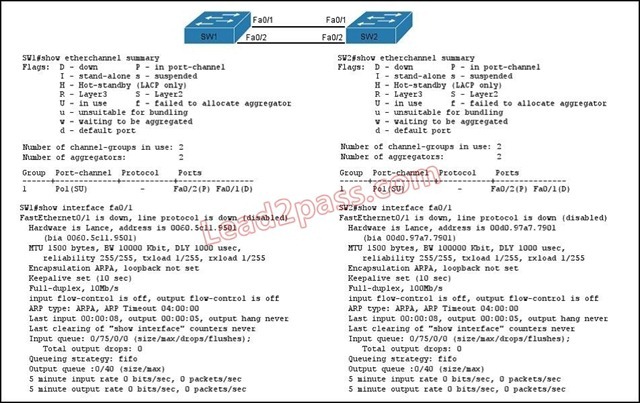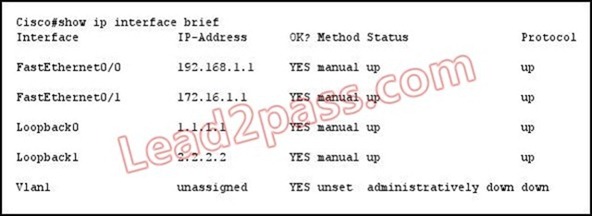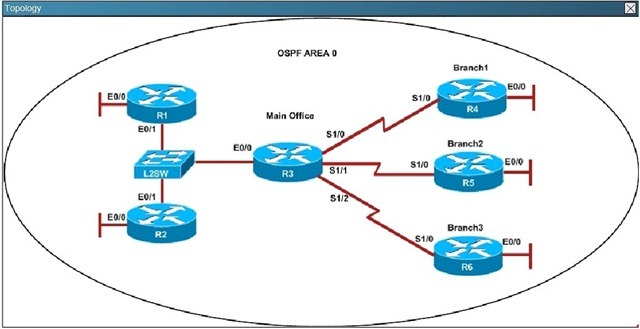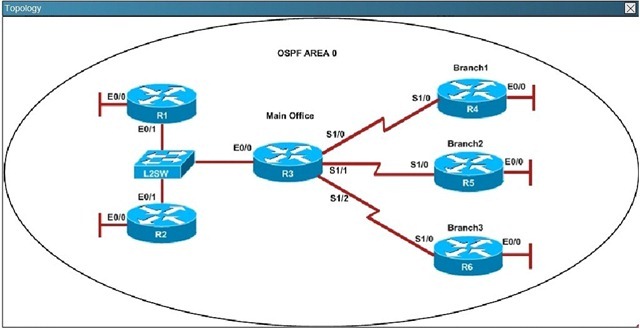2016 September Cisco Official New Released 200-125 Dumps in Lead2pass.com!
100% Free Download! 100% Pass Guaranteed!
Your worries about 200-125 exam completely no more exist, because Lead2pass is here to serves as a guide to help you pass the exam. Lead2pass offers the latest 200-125 PDF and VCE dumps with the new version VCE player for free download. All the 200-125 exam questions and answers are the latest and cover every aspect of 200-125 exam. It 100% ensures you pass the exam without any doubt.
Following questions and answers are all new published by Cisco Official Exam Center: http://www.lead2pass.com/200-125.html
QUESTION 286
What are three factors a network administrator must consider before implementing Netflow in the network? (Choose three.)
A. CPU utilization
B. where Netflow data will be sent
C. number of devices exporting Netflow data
D. port availability
E. SNMP version
F. WAN encapsulation
Answer: ABC
QUESTION 287
Which two statements about the OSPF Router ID are true? (Choose two.)
A. It identifies the source of a Type 1 LSA.
B. It should be the same on all routers in an OSPF routing instance.
C. By default, the lowest IP address on the router becomes the OSPF Router ID.
D. The router automatically chooses the IP address of a loopback as the OSPF Router ID.
E. It is created using the MAC Address of the loopback interface.
Answer: AD
QUESTION 288
What parameter can be different on ports within an EtherChannel?
A. speed
B. DTP negotiation settings
C. trunk encapsulation
D. duplex
Answer: B
QUESTION 289
What are two benefits of using a single OSPF area network design? (Choose two.)
A. It is less CPU intensive for routers in the single area.
B. It reduces the types of LSAs that are generated.
C. It removes the need for virtual links.
D. It increases LSA response times.
E. It reduces the number of required OSPF neighbor adjacencies.
Answer: BC
QUESTION 290
Refer to the exhibit. What set of commands was configured on interface Fa0/3 to produce the given output? 
A. interface FastEthernet 0/3
channel-group 1 mode desirable
switchport trunk encapsulation dot1q
switchport mode trunk
B. interface FastEthernet 0/3
channel-group 2 mode passive
switchport trunk encapsulation dot1q
switchport mode trunk
C. interface FastEthernet 0/3
channel-group 2 mode active
switchport trunk encapsulation dot1q
switchport mode trunk
D. interface FastEthernet 0/3
channel-group 2 mode on
switchport trunk encapsulation dot1q
switchport mode trunk
Answer: B
QUESTION 291
Refer to the exhibit. If the devices produced the given output, what is the cause of the EtherChannel problem? 
A. SW1’s Fa0/1 interface is administratively shut down.
B. There is an encapsulation mismatch between SW1’s Fa0/1 and SW2’s Fa0/1 interfaces.
C. There is an MTU mismatch between SW1’s Fa0/1 and SW2’s Fa0/1 interfaces.
D. There is a speed mismatch between SW1’s Fa0/1 and SW2’s Fa0/1 interfaces.
Answer: D
QUESTION 292
What are two enhancements that OSPFv3 supports over OSPFv2? (Choose two.)
A. It requires the use of ARP.
B. It can support multiple IPv6 subnets on a single link.
C. It supports up to 2 instances of OSPFv3 over a common link.
D. It routes over links rather than over networks.
Answer: BD
QUESTION 293
When a router undergoes the exchange protocol within OSPF, in what order does it pass through each state?
A. exstart state > loading state > exchange state > full state
B. exstart state > exchange state > loading state > full state
C. exstart state > full state > loading state > exchange state
D. loading state > exchange state > full state > exstart state
Answer: B
QUESTION 294
A network administrator creates a layer 3 EtherChannel, bundling four interfaces into channel group 1. On what interface is the IP address configured?
A. the port-channel 1 interface
B. the highest number member interface
C. all member interfaces
D. the lowest number member interface
Answer: A
QUESTION 295
Refer to the exhibit. If the router Cisco returns the given output and has not had its router ID set manually, what value will OSPF use as its router ID? 
A. 192.168.1.1
B. 172.16.1.1
C. 1.1.1.1
D. 2.2.2.2
Answer: D
QUESTION 296
What command sequence will configure a router to run OSPF and add network 10.1.1.0 /24 to area 0?
A. router ospf area 0
network 10.1.1.0 255.255.255.0 area 0
B. router ospf
network 10.1.1.0 0.0.0.255
C. router ospf 1
network 10.1.1.0 0.0.0.255 area 0
D. router ospf area 0
network 10.1.1.0 0.0.0.255 area 0
E. router ospf
network 10.1.1.0 255.255.255.0 area 0
F. router ospf 1
network 10.1.1.0 0.0.0.255
Answer: C
QUESTION 297
What OSPF command, when configured, will include all interfaces into area 0?
A. network 0.0.0.0 255.255.255.255 area 0
B. network 0.0.0.0 0.0.0.0 area 0
C. network 255.255.255.255 0.0.0.0 area 0
D. network all-interfaces area 0
Answer: A
QUESTION 298
Which statement describes the process ID that is used to run OSPF on a router?
A. It is globally significant and is used to represent the AS number.
B. It is locally significant and is used to identify an instance of the OSPF database.
C. It is globally significant and is used to identify OSPF stub areas.
D. It is locally significant and must be the same throughout an area.
Answer: B
QUESTION 299
Which three are the components of SNMP? (Choose three)
A. MIB
B. SNMP Manager
C. SysLog Server
D. SNMP Agent
E. Set
Answer: ABD
Explanation:
SNMP is an application-layer protocol that provides a message format for communication between SNMP managers and agents. SNMP provides a standardized framework and a common language used for the monitoring and management of devices in a network.
The SNMP framework has three parts:
+ An SNMP manager
+ An SNMP agent
+ A Management Information Base (MIB)
The SNMP manager is the system used to control and monitor the activities of network hosts using SNMP. The most common managing system is called a Network Management System (NMS). The term NMS can be applied to either a dedicated device used for network management, or the applications used on such a device. A variety of network management applications are available for use with SNMP. These features range from simple command-line applications to feature-rich graphical user interfaces (such as the CiscoWorks2000 line of products).
The SNMP agent is the software component within the managed device that maintains the data for the device and reports these data, as needed, to managing systems. The agent and MIB reside on the routing device (router, access server, or switch). To enable the SNMP agent on a Cisco routing device, you must define the relationship between the manager and the agent.
The Management Information Base (MIB) is a virtual information storage area for network management information, which consists of collections of managed objects.
QUESTION 300
What are the Popular destinations for syslog messages to be saved?
A. Flash
B. The logging buffer .RAM
C. The console terminal
D. Other terminals
E. Syslog server
Answer: BCE
Explanation:
By default, switches send the output from system messages and debug privileged EXEC commands to a logging process. The logging process controls the distribution of logging messages to various destinations, such as the logging buffer (on RAM), terminal lines (console terminal), or a UNIX syslog server, depending on your configuration. The process also sends messages to the console.
Note: Syslog messages can be written to a file in Flash memory although it is not a popular place to use. We can configure this feature with the command logging file flash:filename.
QUESTION 301
Syslog was configured with a level 3 trap. Which 4 types of logs would be generated (choose four)
A. Emergencies
B. Alerts
C. Critical
D. Errors
E. Warnings
Answer: ABCD
Explanation:
The Message Logging is divided into 8 levels as listed below:
Level Keyword Description
0 emergencies System is unusable
1 alerts Immediate action is needed
2 critical Critical conditions exist
3 errors Error conditions exist
4 warnings Warning conditions exist
5 notification Normal, but significant, conditions exist 6 informational Informational messages
7 debugging Debugging messages
The highest level is level 0 (emergencies). The lowest level is level 7. If you specify a level with the “logging console level” command, that level and all the higher levels will be displayed. For example, by using the “logging console warnings” command, all the logging of emergencies, alerts, critical, errors, warnings will be displayed.
QUESTION 302
What are the benefit of using Netflow? (Choose three.)
A. Network, Application & User Monitoring
B. Network Planning
C. Security Analysis
D. Accounting/Billing
Answer: ACD
QUESTION 303
Which protocol can cause overload on a CPU of a managed device?
A. Netflow
B. WCCP
C. IP SLA
D. SNMP
Answer: D
Explanation:
Sometimes, messages like this might appear in the router console:
%SNMP-3-CPUHOG: Processing [chars] of [chars]
They mean that the SNMP agent on the device has taken too much time to process a request.
You can determine the cause of high CPU use in a router by using the output of the show process cpu command.
Note: A managed device is a part of the network that requires some form of monitoring and management (routers, switches, servers, workstations, printers…).
QUESTION 304
What are the three things that the Netflow uses to consider the traffic to be in a same flow?
A. IP address
B. Interface name
C. Port numbers
D. L3 protocol type
E. MAC address
Answer: ACD
Explanation:
What is an IP Flow?
Each packet that is forwarded within a router or switch is examined for a set of IP packet attributes. These attributes are the IP packet identity or fingerprint of the packet and determine if the packet is unique or similar to other packets. Traditionally, an IP Flow is based on a set of 5 and up to 7 IP packet attributes.
IP Packet attributes used by NetFlow:
+ IP source address
+ IP destination address
+ Source port
+ Destination port
+ Layer 3 protocol type
+ Class of Service
+ Router or switch interface
QUESTION 305
What is the alert message generated by SNMP agents called ?
A. TRAP
B. INFORM
C. GET
D. SET
Answer: AB
Explanation:
A TRAP is a SNMP message sent from one application to another (which is typically on a remote host). Their purpose is merely to notify the other application that something has happened, has been noticed, etc. The big problem with TRAPs is that they’re unacknowledged so you don’t actually know if the remote application received your oh-so-important message to it. SNMPv2 PDUs fixed this by introducing the notion of an INFORM, which is nothing more than an acknowledged TRAP.
QUESTION 306
Which three features are added in SNMPv3 over SNMPv2?
A. Message Integrity
B. Compression
C. Authentication
D. Encryption
E. Error Detection
Answer: ACD
QUESTION 307
In a GLBP network, who is responsible for the arp request?
A. AVF
B. AVG
C. Active Router
D. Standby Router
Answer: B
QUESTION 308
What levels will be trapped if the administrator executes the command router(config)# logging trap 4 (Choose four) ?
A. Emergency
B. Notice
C. Alert
D. Error
E. Warning
Answer: ACDE
Explanation:
The Message Logging is divided into 8 levels as listed below:
Level Keyword Description
0 emergencies System is unusable
1 alerts Immediate action is needed
2 critical Critical conditions exist
3 errors Error conditions exist
4 warnings Warning conditions exist
5 notification Normal, but significant, conditions exist 6 informational Informational messages
7 debugging Debugging messages
If you specify a level with the “logging trap level” command, that level and all the higher levels will be logged.
For example, by using the “logging trap 4 command, all the logging of emergencies, alerts, critical, errors, warnings will be logged.
QUESTION 309
Hotspot Question
Refer to the topology. Your company has decided to connect the main office with three other remote branch offices using point-to-point serial links.
You are required to troubleshoot and resolve OSPF neighbor adjacency issues between the main office and the routers located in the remote branch offices. 
An OSPF neighbor adjacency is not formed between R3 in the main office and R4 in the Branchl office. What is causing the problem?
A. There is an area ID mismatch.
B. There is a Layer 2 issue; an encapsulation mismatch on serial links.
C. There is an OSPF hello and dead interval mismatch.
D. The R3 router ID is configured on R4.
Answer: A
Explanation:
A show running-config command on R3 and R4 shows that R4 is incorrectly configured for area 2:
QUESTION 310
Hotspot Question
Refer to the topology. Your company has decided to connect the main office with three other remote branch offices using point-to-point serial links.
You are required to troubleshoot and resolve OSPF neighbor adjacency issues between the main office and the routers located in the remote branch offices. 
An OSPF neighbor adjacency is not formed between R3 in the main office and R5 in the Branch2 office. What is causing the problem?
A. There is an area ID mismatch.
B. There is a PPP authentication issue; a password mismatch.
C. There is an OSPF hello and dead interval mismatch.
D. There is a missing network command in the OSPF process on R5.
Answer: C
Explanation:
The “show ip ospf interface command on R3 and R5 shows that the hello and dead intervals do not match. They are 50 and 200 on R3 and 10 and 40 on R5.
Pass 200-125 exam with the latest Lead2pass 200-125 dumps. Lead2pass 200-125 exam questions and answers in PDF are prepared by our expert. Moreover, they are based on the recommended syllabus that cover all the 200-125 exam objectives. Comparing with others’, you will find our 200-125 exam questions are more helpful and precise since all the 200-125 exam content is regularly updated and has been checked for accuracy by our team of Cisco expert professionals. Welcome to choose.
200-125 new questions on Google Drive: https://drive.google.com/open?id=0B3Syig5i8gpDbnNGVlNHTzJjcWc
2016 Cisco 200-125 exam dumps (All 545 Q&As) from Lead2pass:
http://www.lead2pass.com/200-125.html [100% Exam Pass Guaranteed]